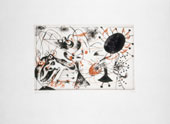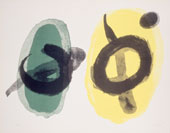- Dates
- —
- Curated by
- Teresa Montaner
The Fundació Joan Miró presents the Joan Miró. Printmaking exhibition, a selection of engravings and lithographs from its collection that will be open to the public from July 2 to September 24, 2013.
Joan Miró. Printmaking covers the different graphic techniques that Miró explored from the 1930s to the 1960s. A significant number of the pieces shown are lithographs and engravings, but other methods are also included, such as intaglio, drypoint, etching, and aquatint. The exhibition suggests how the renewal of the artist's language went hand in hand with his technical advances in printmaking. Close to one hundred works are presented, many of which are parts of larger series.
The exhibition, consisting entirely of pieces from the Foundation's collection, highlights Miró's experimental spirit. By the time the artist delved into printmaking, he was a recognized painter and had long-standing experience with a broad range of materials. The works on exhibit show how Miró's pursuit of printmaking influenced his painting—and how the opposite was equally true.
The selected works are organized chronologically in three sections. The first of these shows Miró's earliest prints, from the 1930s, produced during the Spanish Civil War when the artist sought exile in Paris. In the course of this first period of contact with printmaking, Miró learned the technique at the studio of engraver Louis Marcoussis, and began exploring the use of color by combining two plates. This experimentation with color is featured in the exhibition with several compositions from the Black and red series.
The second section includes lithographs and engravings from the late 1940s. In 1947, Miró spent almost a year in New York, working on a huge mural painting commissioned for Cincinnati. Based on what he learned at S.W. Hayter's print studio, Miró honed his technical knowledge and introduced color into his prints more extensively and skillfully. The works included in this section also reflect the consolidation of the language of signs and symbols that the artist had developed in his earlier period.
Following the end of the Second World War, Miró reestablished contact with Europe, and, with the support of his new dealer Aimé Maeght, increased his focus on printmaking. This helped him reconnect with his poet friends, who frequently asked him to provide illustrations for bibliophile editions of their works. All of these artistic exchanges played into the language of Miró's graphic production.
The exhibition is rounded out by a screening of Clovis Prévost's documentary Miró, lithographie d’une affiche, showing Miró at work on several lithographs at the Arte print studio in Paris. The footage, shot in the early 1970s, provides a detailed record of the process involved in producing a lithograph.



